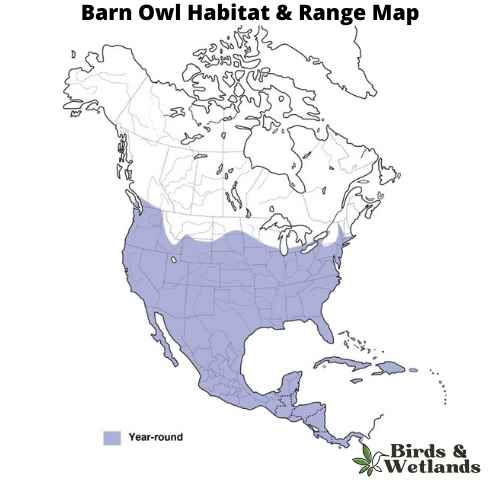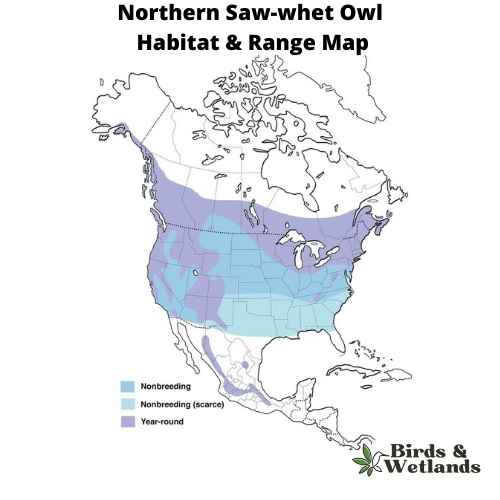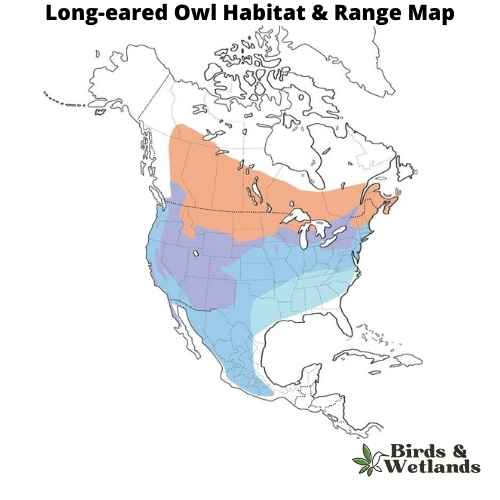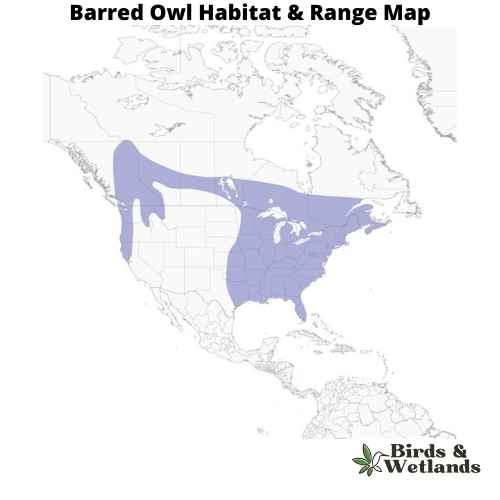Alabama, the heart of the American South, is a diverse ecological tapestry that plays host to an array of remarkable wildlife, including a fascinating variety of owls – which are birds of prey. The state’s rich natural landscapes, from the expansive river deltas to dense woodland areas, provide a haven for these nocturnal birds of prey.
Their elusive and mysterious nature attracts bird watchers and nature enthusiasts alike, making Alabama a beloved destination for those seeking the silent, yet commanding, presence of owls in the wild.
Alabama Owls
| Owl Species | Frequency in Alabama | Specific Locations in Alabama |
|---|---|---|
| Barn Owl | Uncommon | Found in open farmland areas, old buildings and barns around Madison County. |
| Eastern Screech-owl | Common | Spotted in dense woods and suburban areas of Birmingham and Tuscaloosa. |
| Great Horned Owl | Very common | Observed in large wooded parks like Oak Mountain State Park, and suburban areas across the state. |
| Northern Saw-whet Owl | Rare | Mostly seen in the northernmost parts of the state, especially around Monte Sano State Park. |
| Short-eared Owl | Uncommon | Mostly spotted in open fields and meadows, particularly around the Wheeler National Wildlife Refuge. |
| Long-eared Owl | Rare | Sightings often reported in thickly wooded areas around the Bankhead National Forest. |
| Barred Owl | Very common | Frequently seen in wet woodland areas, especially along the Mobile-Tensaw River Delta. |
Other owls which sometimes visit Alabama include the Flammulated owl, burrowing owl, known for their brown feathers. The snowy owl has not been recorded in Alalbama as snowy owls prefer colder climates. See here a full list of all birds of prey found in Alabama.
Species of Owls Found in Alabama
Barn Owl (Tyto alba)


Barn Owl Sound
Scientific Name: Tyto alba
Length: 13 to 15 in
Wingspan: 31 to 37 in
Weight: 9.2 oz
The Barn Owl is a widespread species of owl known for its distinctive heart-shaped facial disc.
Barn Owls are medium-sized owls, they are pale overall with golden-brown wings and back, contrasted by a white face, chest, and belly. Their most notable feature is their heart-shaped facial disc, which helps channel sound to their ears.
Barn Owls are typically found in open habitats, including farmland, woodland, and marshes. They are named for their habit of nesting in human structures such as barns, church towers, and in the hollows of large trees. These owls are nocturnal, hunting at night and roosting during the day.
The diet of Barn Owls primarily consists of small mammals, particularly rodents such as mice and rats. They are known for their silent flight, which allows them to sneak up on their prey without detection.
Barn Owls have a unique nesting behavior. They do not build nests, but instead, lay their eggs directly on the bare surface of a secluded ledge or cavity. A female typically lays 4-7 eggs, and both parents help incubate the eggs and care for the chicks.
Eastern Screech-Owl (Megascops asio)


Eastern Screech-Owl Sound
Scientific Name: Megascops asio
Length: 6 to 10 in
Wingspan: 8 to 24 in
Weight: 4 – 8.5 oz
The Eastern Screech-Owl is a small owl species native to most wooded environments of the eastern half of North America, from the Canadian provinces to Florida and Texas.
Eastern Screech-Owls are relatively small and exhibit a complex pattern of gray or reddish-brown coloration, which provides excellent camouflage against tree bark.
These owls are known for their distinctive call, which is often described as a haunting trill or a whinny-like sound. Despite their name, they do not actually produce a “screech.”
Eastern Screech-Owls feed on a variety of prey, ranging from small mammals and birds to insects and even earthworms. It is primarily nocturnal, hunting at night from a low perch and swooping down onto prey.
Eastern Screech-Owls nest in tree cavities or abandoned woodpecker nests, but they readily adapt to nesting boxes where natural cavities are not available. They typically lay between 2 to 6 eggs, which are incubated primarily by the female.
Great Horned Owl (Bubo virginianus)


Great Horned Owl Sound
Scientific Name:Bubo virginianus
Length: 18.1-24.8 in
Wingspan: 39.8-57.1 in
Weight: 32.1-88.2 oz
The Great Horned Owl is a large owl with long wings and a large head. It’s one of the most common owls in North America.
Great Horned Owls are large, stocky birds with soft feathers that are gray to brown on their backs and white on their chests. Their faces are characterized by two black “ear” tufts, which can be raised or flattened depending on the owl’s mood. The eyes are yellow, orange, or red in color.
The habitat of the Great Horned Owl is a variety of different environments such as forests and deserts. They also live near water sources such as lakes, streams and rivers where they can hunt for fish.
The diet of the Great Horned Owl consists primarily of small mammals such as mice and rats; however they will also eat other rodents such as squirrels, rabbits and porcupines. They have been known to eat skunks too.
Northern Saw-whet Owl (Aegolius acadicus)


Northern Saw-whet Owl Sound
Scientific Name: Aegolius acadicus
Length: 17–22 cm (6.7–8.7 in)
Wingspan: 42–56.3 cm (16.5–22.2 in)
Weight: 54 to 151 g (1.9 to 5.3 oz)
The Northern Saw-whet Owl is a tiny, speckled gray owl and it’s one of the smallest owls in North America. It’s also known as the Little Owl or Wood Owl in some areas.
Northern Saw-whet Owls have dark brown eyes, white eyebrows, and yellow beak. It has brownish-grey feathers that are spotted with white. The owl’s legs are covered in feathers and appear nearly invisible when the bird is perched on a branch or tree.
In the winter they migrate south to warmer climates. They prefer to live in dense coniferous forest with large trees but will occasionally nest in shrubs or other vegetation that can protect them from predators.
The Northern Saw-whet Owl eats mice and voles (small rodents), small birds, frogs, salamanders, moles and shrews, but unlike most owls they chop their prey up and spread over a few meals. They will also eat insects like beetles and grasshoppers if they are available. It hunts from a perch at night using its excellent hearing to locate prey items within about 30 feet (9 meters) of its nest.
These owls nest in tree cavities usually located close to water sources such as lakes or rivers where they can find their food source (insects). They lay 2-4 eggs at one time which incubate for about 30 days before hatching.
Short-eared Owl (Asio flammeus)


Short-eared Owl Sound
Scientific Name: Asio flammeus
Length: 13–17 in
Wingspan: 33 to 43 in
Weight: 7.3–16.8 oz
The Short-eared Owl is a medium-sized owl species with a wide distribution, found across North and South America, Europe, Asia, and many Pacific islands. Despite its name, the “ears” of the Short-eared Owl are not often visible, as they are small and tend to blend with the bird’s feathers.
The owls are predominantly brown with buff and white accents throughout their body and wings, and dark patches around their yellow eyes.
Short-eared Owls diet consists largely of small mammals, especially voles. However, they are opportunistic hunters and will also prey on a variety of other animals, including other birds, when available.
Their habitat is characterized by open areas like grasslands, marshes, and tundra. They nest on the ground, which is unusual for owls, and this makes them vulnerable to ground predators. As such, they often live in areas with tall grasses or other ground cover for protection.
The long-eared owl (Asio otus)


Long-eared Owl Sound
Scientific Name: Asio otus
Length: 12 and 16 in
Wingspan: 2 ft 10 in to 3 ft 4 in
Weight: 5.6 to 15.3 oz
The Long-eared Owl is a medium-sized owl species known for its distinctively long ear tufts, which can be raised or lowered depending on the bird’s mood or intention.
Long-eared Owls have mottled brown and cream plumage, which provides excellent camouflage among the trees. Their most distinctive features are their long, black-tipped ear tufts, which are set closer to the center of the head than in most other owl species.
These owls inhabit a wide variety of habitats, including deciduous and coniferous forests, woodlands, and even semi-deserts.
The Long-eared Owl’s diet primarily consists of small mammals, especially voles, but they will also take small birds and insects. They are skillful hunters, often capturing prey from a perch or in flight.
In terms of nesting behavior, Long-eared Owls do not construct their own nests, instead they take over old nests built by other bird species, usually those of corvids or other large birds. They lay an average of 4 to 5 eggs, which are incubated by the female while the male provides food.
Barred Owl (Strix varia)


Barred Owl Sound
Scientific Name: Strix varia
Length: 40 to 63 cm (16 to 25 in)
Wingspan: 96 to 125 cm (38 to 49 in)
Weight: 468 to 1,150 g
The Barred Owl is a medium-sized owl with a barred pattern on its chest and belly. They have large yellow eyes that allow them to see well in low light conditions. Their ears are not very large which means they do not hear very well but they have excellent hearing abilities which allow them to detect sounds up to 1 mile away. Their feathers are brown and streaked with white, and they have black bars on their chests and wings.
Their habitats include forests, woodlands, orchards, parks, farmland and suburban backyards.
Barred Owls (also known as hoot owl) eat small mammals such as mice, rats and squirrels. They also eat insects such as beetles or grasshoppers. These owls hunt during the day when it is light out so that they can see their prey better than at night when they would be using senses other than sight like sound or smell to find their food source.
Barred owls are monogamous birds which means they mate for life. They build nests in trees or cavities on the ground and lay 2-4 eggs per year. The incubation period for these eggs lasts about 28 days before hatching takes place.
Where to Spot Alabama’s Owls
Oak Mountain State Park, Pelham: As Alabama’s largest state park, it offers diverse habitats, which attract a wide array of owl species sometimes burrowing owls. It is especially known for sightings of the Great Horned Owl. The park’s various nature trails and overnight campgrounds make it a perfect spot for owl watching, particularly during the dusk and dawn.
Wheeler National Wildlife Refuge, Decatur: This large refuge is known for its extensive wetlands and forested areas, making it a popular spot for different owl species, including the Short-eared Owl. The visitor centre often provides useful information about recent sightings, offering an added benefit for bird watchers.
Monte Sano State Park, Huntsville: A top location for spotting the less common Northern Saw-whet Owl. Located in northeastern Alabama, this park’s extensive woodland areas are perfect for owls. The camping facilities can accommodate those wishing to stay overnight for nocturnal bird watching.
Bankhead National Forest, Double Springs: This forest is rich in biodiversity and is known for spotting the elusive Long-eared Owl. Bird watchers can venture on the forest’s many hiking trails to spot these magnificent birds, especially in the cooler months when they are more active.
Mobile-Tensaw River Delta, Mobile: One of the largest river deltas and wetland areas in the country, it is especially known for the Barred Owl. A variety of eco-tours and cruises are available for bird watchers to explore the area’s rich wildlife.
Travelling from Alabama there are plenty of owls in neighbouring states. In Georgia Owls, the Chattahoochee National Forest is known for its diverse owl population. The Florida Owls can be observed in Everglades National Park. Owls in Mississippi inhabit Noxubee National Wildlife Refuge, whilst Owls in Tennessee are found in Great Smoky Mountains National Park.
Remember to respect the wildlife and adhere to birdwatching ethics when observing these magnificent creatures. Always maintain a safe distance and avoid disturbing their natural behaviour.


